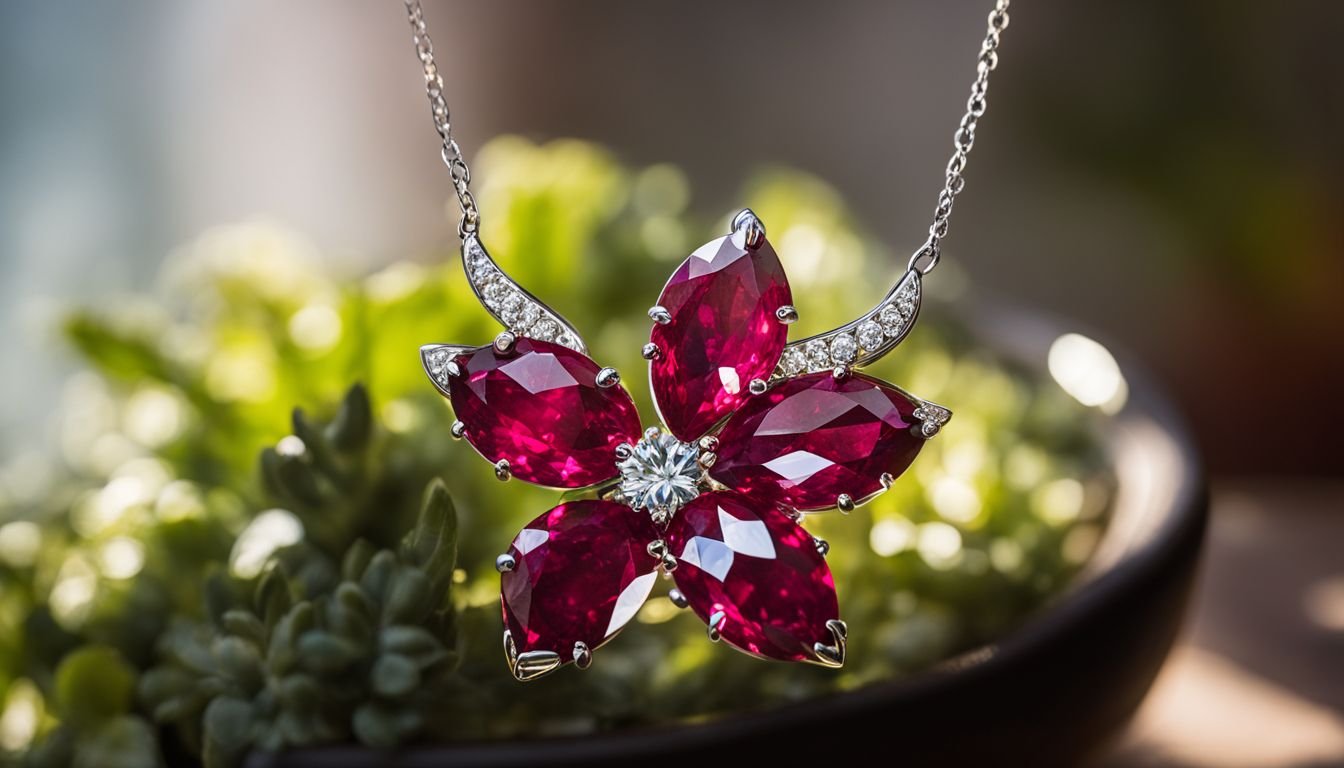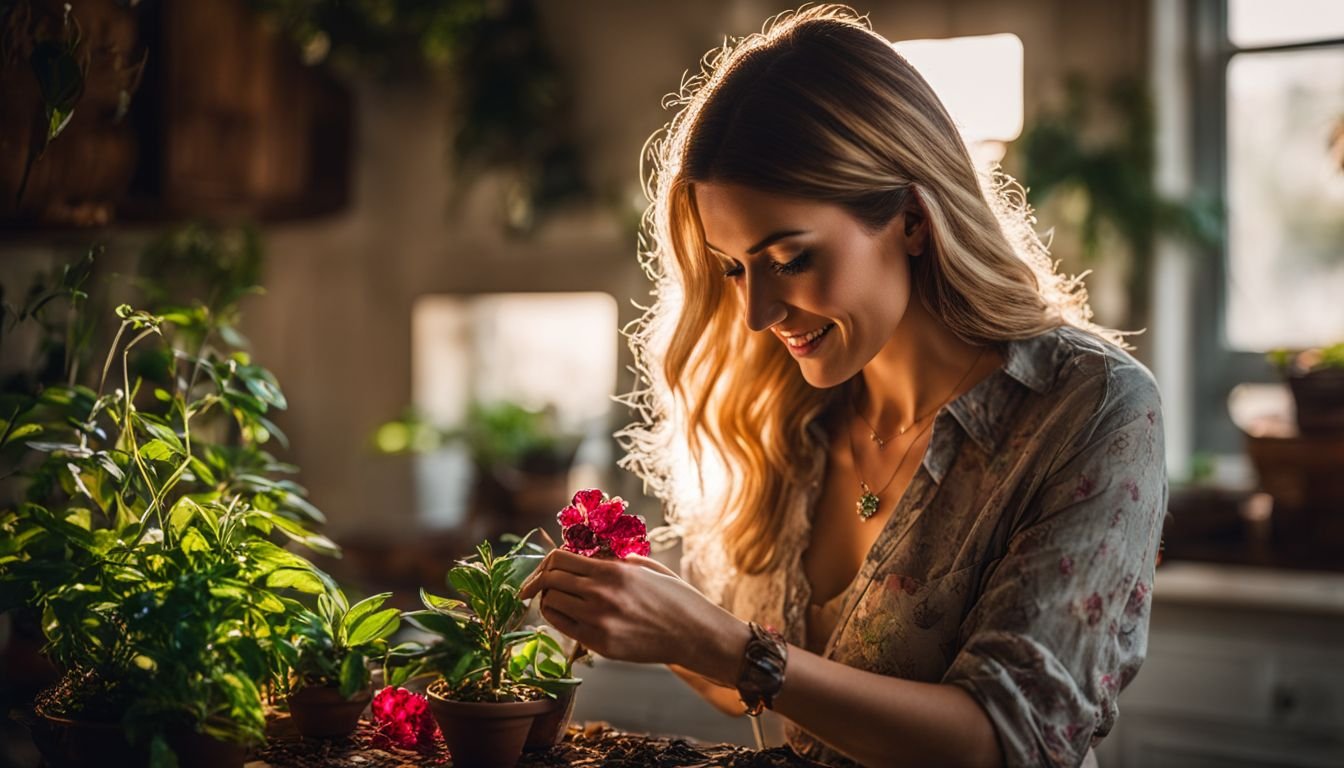Caring for plants at home can sometimes be a bit of a head-scratcher, especially when you’re dealing with a unique and eye-catching one like the Ruby Necklace. Many of us have faced the dilemma of seeing this beautiful trailing succulent lose its vibrant color or fail to bloom despite our best efforts.
We’ve all been in that boat, trying our hardest to keep these little beauties thriving and vibrant in our Aussie homes. After diving deep into research and gathering all the essential facts, we’ve uncovered effective care tips that genuinely make a difference.
The Ruby Necklace plant, or othonna capensis, isn’t just another pretty addition to your garden or balcony; it’s a drought-tolerant trooper known for its stunning purple-pink stems and water-storing leaves.
This South African native loves basking under bright indirect sunlight but will surprise you by turning red when it cops too much direct sun heat. Our article is chock-a-block with simple yet powerful care strategies from proper lighting to battling pests, tailored specifically for Australian conditions.
Keen to see your trailing beauty thrive? Keep on reading!
Key Takeaways
- Give your Ruby Necklace plant plenty of bright, indirect sunlight to keep its colours vivid and encourage blooming. Move it if it starts stretching out or losing colour.
- Water the plant only when the soil has completely dried out to prevent root rot. Use a pot with good drainage and never leave water sitting at the bottom.
- Choose well – draining, slightly acidic soil for your Ruby Necklace and fertilise lightly during its growing season for best results.
- Prevent pests like mealybugs and scale by checking your plant regularly. Treat any infestations promptly with soapy water wipes.
- Pruning overgrown branches and propagating from healthy stem segments can help maintain your plant’s health and allow you to grow more Ruby Necklace plants.
Essential Care for Ruby Necklace Plant

Caring for a Ruby Necklace Plant starts with giving it the right amount of light and water. This pretty string of beads thrives in bright, indirect sunshine and needs soil that won’t stay wet for too long to avoid root issues.
Appropriate Lighting
Getting the right light for a Ruby Necklace plant is vital. These succulents need a few hours of sun every day and do best in bright, indirect light. Think of placing them near a window where sunlight can reach them without getting too harsh.
This kind of lighting helps them show off their vibrant purple colour and bloom with yellow daisy-like flowers.
In areas with less natural light, you might notice your plant’s leaves turning green instead of keeping their rich hue. A lack of adequate light also makes these plants stretch out, looking leggy and less attractive.
To keep your Ruby Necklace looking its best, ensure it gets plenty bright but soft light throughout the day.
“Bright, indirect sunlight keeps the Ruby Necklace’s colours vivid and encourages blooming.”
Ideal Watering Techniques
Watering your Ruby Necklace plant properly makes a huge difference in its health and growth. This drought-tolerant succulent loves to dry out between drinks. It’s best to wait until the potting mix completely dries before watering again.
Stick your finger into the soil; if it feels dry a couple of inches down, it’s time to water thoroughly. Make sure you don’t just sprinkle the surface; the water needs to reach deep where the roots are.
Too much love in form of water can harm this beauty by causing root rot, especially since it likes well-draining earth. Use pots with good drainage holes and avoid letting excess water sit at the bottom of hanging baskets or display plantings.
In rock gardens or when using as a charming hanging basket plant, ensure they’re placed where rainwater won’t pool around them.
Now that we’ve got watering down pat, let’s look into providing your Ruby Necklace with the right blend of soil and nutrients to flourish even more.
Suitable Soil and Fertiliser
We know that our Ruby Necklace plants thrive in well-draining, porous ground with a bit of acidity, ideal pH between 6.0 and 6.5. Choosing the right potting mix is crucial for drainage and to avoid water logging which can harm this succulent’s roots.
Mixes designed for cacti or little pickles work great because they allow air and water to move freely around the plant’s roots.
For fertilisation, we go easy on it. A low-nitrogen feed meant for daisies encourages growth without overwhelming our Ruby Necklaces. We apply this sparingly, given that these beauties aren’t greedy eaters in Australia’s soils.
With just enough nutrients from occasional feeding, they dazzle us with vibrant colours and health.
Next up, let’s talk about how we keep them looking their best with tips on potting and repotting.
Extra Care for Ruby Necklace Plant

Giving your Ruby Necklace Plant extra love means knowing how to pot and repot it properly. Use pots that let water flow out easily and refresh the potting mix to keep your plant happy.
Also, cutting back overgrown branches or taking stem pieces can help you grow new plants easily. This way, your garden will have more of these stunning daisy family members.
Potting and Repotting
Potting and repotting are crucial for keeping your Ruby Necklace Plant healthy. These steps ensure it has enough room to grow and prevent root problems.
- Choose the right container: Select a pot made of breathable materials, like terracotta or ceramic. This helps water evaporate better, keeping the roots dry and healthy. Make sure the new vessel is only slightly larger than the old one.
- Prepare potting mix: Mix together a light, well-aerating growing medium that mimics their natural environment. A blend of peat, perlite, and sand makes for an excellent base. This type of mix ensures quick drainage and prevents water from sitting around the roots.
- Repot at the right time: Spring is the best season for this job. The plant is waking up from its dormant winter phase and ready to grow. Repotting now gives it a fresh start with plenty of time to adjust before the hot months.
- Gently remove the plant: Ease your Ruby Necklace out of its current home by tipping the container sideways and supporting the plant with your hand. Be careful not to tug on the stems too hard.
- Check for pests and diseases: Before putting your plant into its new pot, inspect the root ball for any signs of disease or pests like mealybugs or scale insects. Trim off any damaged or rotting roots with clean scissors.
- Place in new pot: Fill a third of the new pot with your prepared soil mix, place your plant in it, then add more soil around its sides gently tamping down as you go to remove air pockets but without compacting it too tightly.
7: **Water thoroughly**: Once repotted, give your plant a good drink so that water runs out of the bottom drainage holes. This helps settle any displaced soil around the roots.
8: **Follow up care**: Keep your recently potted Ruby Necklace in a shady spot to help it recover without stress from direct sunlight’s heat or intensity for about a week before moving it back to its usual bright spot.
We all enjoy seeing our plants thrive, and giving them a fresh start through potting and repotting is part of that joyous journey.
Pruning and Propagation
After we’ve discussed how to pick the right pot and soil for your Ruby Necklace succulent, it’s time to focus on keeping it healthy and spreading its beauty. Pruning and propagating are two key steps in this process.
Pruning helps your plant stay vibrant:
- Use clean, sharp scissors or shears.
- Cut back any overgrown branches or stems. This encourages new growth.
- Remove dead or yellow leaves to keep the plant looking fresh.
- Doing this during the growing season gives the best results.
Propagation allows you to create more plants:
- Choose healthy stem segments for cuttings.
- Use a knife or scissors cleaned with alcohol to avoid disease spread.
- Allow the cuttings to dry for a few days until the cut end forms a callus.
- Plant these dried cuttings in well – draining soil mixed with potting soil.
- Keep them in indirect sunlight and water when the soil feels dry.
Both pruning and propagation not only maintain the health of your Ruby Necklace plant but also help you grow your collection without having to purchase new plants. These simple yet effective techniques ensure your succulents thrive and multiply, sharing their unique beauty throughout your home or garden in Australia.
Dealing with Common Pests and Diseases
We all face challenges in keeping our plants healthy, and our Ruby Necklace succulent is no different. One of the main troubles we come across is root rot. This nasty problem often happens if we water the plant too much.
Our Ruby Necklace doesn’t like having “wet feet,” which means its roots shouldn’t sit in water for long periods. To avoid this, make sure you plant it in well-draining soil and only give it a drink when the top inch of soil feels dry to the touch.
Another issue that requires our attention is mould and fungal diseases. These can sneak up on our beloved plant if there’s not enough air blowing around or if it gets too wet. Keeping your Ruby Necklace in a spot where air moves freely helps prevent these unwelcome guests.
Pests like mealybugs and scale also love making homes on succulents like ours. Spotting these early is key to keeping them under control. A good look at your plant every now and then helps catch trouble before it spreads too far.
If pests show up, wiping them away with a soft cloth dipped in soapy water can kick them out of their new home on your plant.
“A stitch in time saves nine; regular checks keep pests off the vine.”
Fertilisation plays its part too – but remember, less is more here! Overdoing it with fertiliser can harm more than help, so stick to feeding your Ruby Necklace lightly during its growing season for best results.
In dealing with common pests and diseases that target our lovely hanging friend, knowing what problems could arise gives us an edge in prevention and treatment—keeping things simple yet effective ensures our green companion thrives.
Conclusion
Caring for a Ruby Necklace plant in Australia brings joy and vibrant color to any space. This hardy succulent loves bright light but thrives just as well in part shade, making it perfect for both outdoor gardens and indoor displays.
Ensure the soil is mildly acidic and drains well to prevent water from sitting around the roots. If pests show up or diseases appear, tackling them early keeps your plant healthy. Remember, with simple steps like proper lighting, watering, and occasional pruning, your Ruby Necklace will flourish beautifully throughout the year.
FAQs
1. Where should I place my Ruby Necklace plant in Australia?
Place your Ruby Necklace plant in part shade to protect it from the harsh Australian sun while still giving it enough light to grow.
2. How can I propagate a Ruby Necklace plant?
You can propagate a Ruby Necklace plant by using stem cuttings. Just snip off a healthy piece, let it dry for a day, and then plant it in soil.
3. What type of soil is best for growing a Ruby Necklace plant?
Ruby Necklace plants thrive in acidic soil that drains well, ensuring they get the right nutrients without waterlogging.
4. How often should I water my Ruby Necklace plant?
Water your Ruby Necklace plant when the top inch of soil feels dry to the touch, making sure not to overwater and risk root rot.
